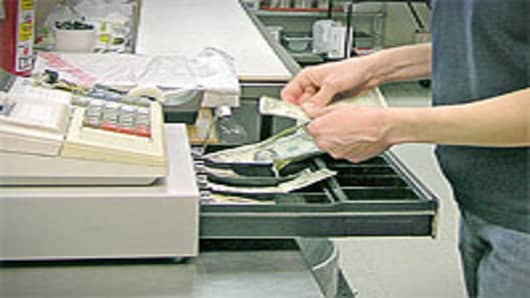Economists are busy upgrading their economic forecasts for 2010, but don’t start the “Happy New Year” cheers just yet.
Some forecasters are already calling for the economy to grow between four and five percent in the coming year, but that’s after the most brutal recession in three decades.
“You have to remember that you’re starting from a low base,” says Chris Varvares, president of the economic consulting firm Macroeconomic Advisers, which in forecasting four percent GDP growth is among the more bullish views.
“We’re getting a snapback that, when judged with those from other deep recessions, is pitiful,” he quickly adds, comparing the economy to a intensive care patient recovering from a near fatal auto accident.
OK, now put away your noisemakers and hats.
“Sure there are a lot of tailwinds, a lot of pent up demand," says Nariman Behravesh, chief economist at Global Insight, which is expecting economic growth in the 2.0-to-2.5-percent range for much of 2010, at the low end of forecasts. “All that means is that there is a recovery in place that is sustainable but not strong."
In the middle of those forecasts is the National Association of Business Economists, which in late November raised its 2010 GDP to 3.2 percent. That happens to be what the White House is calling for in its most recent economic outlook.
Consuming Questions
Like most things about the economy over the past couple years, 2010 will turn on the consumer and housing sectors. The other big factor this time around is unemployment.
Together, they represent something of a Bermuda Triangle for the market.
“The biggest drawback, the big unknown, is the massive amount of debt households have,” says Christian Weller of the University of Massachusetts and the Center for American Progress. “A combination of employment and wage growth should help, but it’s an unknown. We've never had this much debt before.”
Weller is not in the business of making forecasts, but David Resler, chief economist at Nomura Securities, has been doing it for more than two decades.
Resler expects personal consumption to grow at a slower pace (2.3 percent) than the overall economy (2.7 percent).
Nomura estimates that the $9 trillion in wealth losses of 2008 and early 2009 will cut long-run consumer spending by about $300-$700 billion. What’s more, though the debt service-to- disposable income ratio has fallen sharply in the past year, it remains well above the 30-year average.
“Households are going to use any wealth accumulation to pay down debt,” says Resler. “That's going to be a continuing strain on the economy.”
Others, such as Varvares, are ruling out such a drag because of the recent rebound in wealth---a nine month stock market rally has helped--as well as continuing increases in disposable income and wages.
A frugal, cautious consumer mindset, however, has been a drag on housing, especially in an environment of falling prices, in recent years.
Hardly anyone expects housing to remain a strain on the economy—there’s something of a consensus that home prices have bottomed—but it won’t be the engine it was in the past. Expectations are largely modest.
Resler expects housing starts to hit 730,000 for the year, NABE forecasts 800,000, Varvares 880,000. All of those, however are below the 2008 level. Any recovery in single family homes is now being somewhat undermined by weakness in multifamily.
Something bordering on an optimistic can be found in Ram Bhagavatula, managing director at the hedge fund Combinatorics Capital.
“Housing has bottomed,” says Bhagavatula, who is forecasting housing starts of one million. “There’s been a lot of postponed housing consumption.”
Bhagavatula says he’ll probably be revising his current GDP estimate of 3.5 percent to somewhere between 4.0-4.5 percent come January.
Nevertheless, he warns that the “strength of the recovery will be the big surprise. The market forecast is way too optimistic.”
Jobs, Jobs, Jobs
Optimism, however, is not a word associated with the job market. Though most say the jobless rate either peaked at 10.3 in October or will edge a fraction higher than that in early 2010 (Global Insight, for one, expects 10.5 percent), no one has great expectations for improvement.
Forecasts above nine and a half percent for the jobless rate are common. One culprit—housing.
“A lot of employment in past years has been driven by the expansion in homebuilding,” says Resler of Nomura, which expects the jobless rate to drop to 9.7 percent.
The outlook for job creation is somewhat more positive. Most expect the first job gains to appear in the next month or two.
"We're going to see progress on job growth," says Weller, who is encouraged by government efforts on job creation.
“I expect plus-250,000 a month by the spring,” says Michael Mussa, a former International Monetary Fund economist, now with the Peterson Institute for International Economics.
Mussa is not among those raising his forecast; he’s been calling for a five-percent GDP growth rate in 2010 since early this year, arguing that deep contractions beget steep recoveries in both growth and jobs.
With forecasts like these, it almost goes without saying that inflation is expected to be under control. The worst-case scenario is 2.3 percent for core CPI (Bhagavatula); the best is 1.1 percent for core PCE (Varvares)
Inflation appears to be less of a consideration for the Federal Reserve in deciding when to first raise interest rates than the labor market and economists' predictions run the gamut.
The soonest--where a consensus seems to be forming—is mid-year. The latest is the first half of 2011, assuming the worst case for the labor market. More than a few others expect the central bank to wait until late summer or early fall 2010.
“It’s worried about this lackluster recovery,” says Behravesh.




